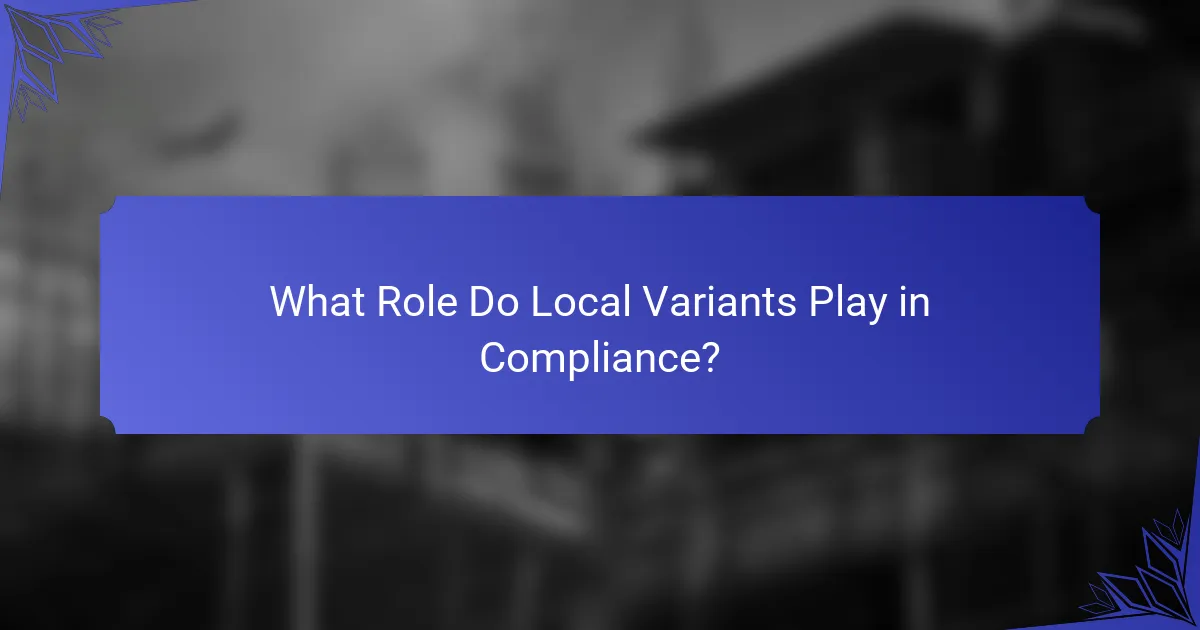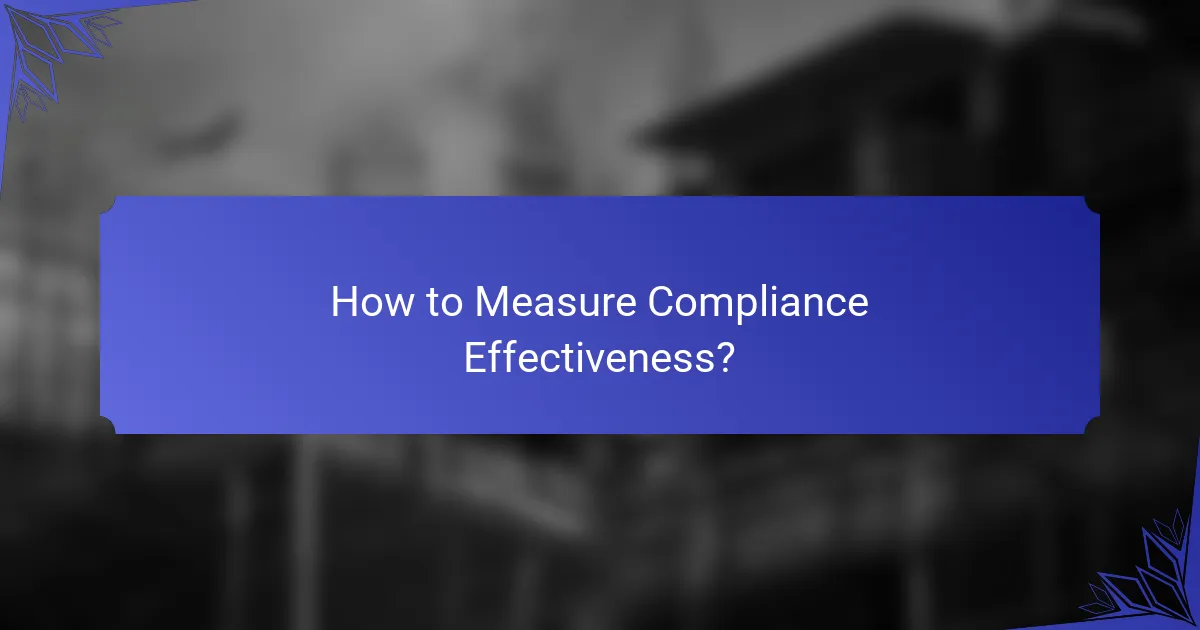Understanding regulatory requirements is crucial for businesses aiming to ensure compliance and foster trust with stakeholders. Effective entry strategies involve a comprehensive assessment of market conditions and regulatory landscapes, while also identifying potential partners. However, companies often face challenges such as navigating complex regulations and adapting to evolving laws, which can significantly impact their operations and profitability.

What Are the Key Regulatory Requirements for Compliance?
Key regulatory requirements for compliance involve understanding and adhering to laws and standards that govern specific industries. Compliance ensures that businesses operate within legal frameworks, mitigating risks and fostering trust with stakeholders.
Industry-specific regulations
Industry-specific regulations vary widely depending on the sector, such as finance, healthcare, or manufacturing. For instance, the financial sector must comply with regulations like the Dodd-Frank Act in the U.S. or the MiFID II in Europe, which dictate transparency and risk management practices.
Companies should conduct thorough research to identify applicable regulations and ensure they have the necessary systems in place to comply. Regular audits and updates to compliance strategies can help mitigate risks associated with non-compliance.
International compliance standards
International compliance standards, such as ISO certifications, provide frameworks for quality management, environmental responsibility, and information security. These standards help businesses operate globally by ensuring consistency and reliability in their practices.
Adopting international standards can enhance a company’s reputation and facilitate entry into new markets. However, businesses must be prepared to invest in training and resources to meet these standards effectively.
Local legal frameworks
Local legal frameworks encompass national and regional laws that govern business operations. These laws can include labor regulations, tax obligations, and environmental laws, which vary significantly across countries.
Understanding local legal requirements is crucial for compliance. Companies should consult with legal experts familiar with local laws to avoid penalties and ensure smooth operations.
Documentation and reporting obligations
Documentation and reporting obligations require businesses to maintain accurate records and submit regular reports to regulatory bodies. This may include financial statements, compliance audits, and environmental impact assessments, depending on the industry.
To streamline compliance, companies should implement robust documentation practices and utilize software solutions that facilitate reporting. Regular training for staff on compliance documentation can help prevent errors and ensure timely submissions.

How to Develop Effective Entry Strategies?
To develop effective entry strategies, businesses must assess market conditions, identify potential partners, and navigate regulatory landscapes. A well-rounded approach combines thorough market analysis, strategic partnerships, and a clear understanding of compliance requirements.
Market analysis and research
Conducting market analysis and research is crucial for understanding the competitive landscape and consumer behavior. This involves gathering data on market size, growth potential, and customer preferences, which can guide decision-making.
Utilize tools like surveys, focus groups, and industry reports to gain insights. For example, if entering the European market, consider factors such as local demand trends and cultural nuances that may affect product acceptance.
Partnerships with local firms
Forming partnerships with local firms can enhance market entry success by leveraging established networks and local expertise. These partnerships can provide valuable insights into consumer preferences and regulatory requirements.
When selecting partners, look for firms with a strong reputation and complementary strengths. For instance, a technology company might partner with a local distributor to streamline logistics and enhance market reach.
Regulatory navigation strategies
Navigating regulatory requirements is essential for compliance and successful market entry. Familiarize yourself with local laws, industry standards, and any necessary permits or licenses that may be required.
Consider engaging local legal experts or consultants who can provide guidance on regulatory frameworks. For example, in the EU, understanding GDPR compliance is critical for any business handling personal data.

What Challenges Do Businesses Face in Compliance?
Businesses encounter various challenges in compliance, including navigating complex regulations, managing costs, and adapting to changing laws. These obstacles can hinder operations and impact profitability if not effectively addressed.
Complexity of regulations
The complexity of regulations can vary significantly by industry and region, making compliance a daunting task. Businesses must understand not only local laws but also international standards if they operate globally. For instance, the General Data Protection Regulation (GDPR) in Europe imposes strict data protection requirements that companies must follow.
To manage this complexity, businesses should invest in compliance training for staff and consider consulting legal experts who specialize in their industry. Regular audits can also help identify gaps in compliance and streamline processes.
Cost of compliance
The cost of compliance can be substantial, often consuming a significant portion of a company’s budget. This includes expenses related to hiring compliance officers, implementing necessary technology, and conducting regular training sessions. For small businesses, these costs can be particularly burdensome, potentially leading to financial strain.
To mitigate these costs, businesses can prioritize compliance activities based on risk assessment and focus on the most critical regulations. Leveraging technology, such as compliance management software, can also reduce manual effort and lower costs over time.
Changing regulatory landscapes
Regulatory landscapes are continually evolving, which poses a challenge for businesses striving to stay compliant. Changes can arise from new legislation, shifts in political climates, or emerging industry standards. For example, recent changes in environmental regulations in the United States have required companies to adapt their practices quickly.
To navigate these changes effectively, businesses should establish a proactive compliance strategy that includes monitoring regulatory updates and engaging with industry associations. Regularly reviewing and updating compliance policies can help ensure that organizations remain aligned with current requirements.

What Are the Best Practices for Regulatory Compliance?
Best practices for regulatory compliance involve establishing a proactive framework that ensures adherence to laws and regulations relevant to your industry. This includes regular updates, training, and leveraging technology to streamline compliance processes.
Regular training and updates
Regular training is essential for keeping employees informed about compliance requirements and changes in regulations. Schedule training sessions at least annually, and consider additional updates whenever significant regulatory changes occur.
Utilize a mix of training methods, such as workshops, online courses, and real-world scenarios to enhance understanding. Encourage employees to ask questions and clarify any uncertainties during these sessions.
Utilizing compliance technology
Compliance technology can significantly improve efficiency and accuracy in meeting regulatory requirements. Consider using software solutions that automate compliance tracking, reporting, and documentation processes.
Look for tools that offer features like real-time monitoring and alerts for regulatory changes. This proactive approach helps organizations stay ahead of compliance issues and reduces the risk of penalties.
Engaging with legal experts
Engaging with legal experts ensures that your compliance strategies are sound and up-to-date. Regular consultations with attorneys or compliance specialists can provide insights into complex regulations and help navigate potential challenges.
Establish a relationship with legal professionals who specialize in your industry. This partnership can be invaluable for interpreting regulations and implementing best practices tailored to your specific needs.

What Role Do Local Variants Play in Compliance?
Local variants significantly influence compliance by dictating specific regulations and standards that businesses must adhere to in different regions. Understanding these local requirements is crucial for successful market entry and ongoing operations.
Understanding regional laws
Regional laws vary widely and can include regulations on labor, environmental standards, and consumer protection. For example, the European Union has stringent data protection laws under the General Data Protection Regulation (GDPR), which differ from those in the United States. Companies must conduct thorough research to identify and understand these legal frameworks to avoid penalties.
Additionally, local laws may require businesses to obtain specific licenses or permits before operating. This can include health and safety certifications, which are essential in industries like food service and manufacturing. Failing to comply with these laws can lead to significant fines or operational shutdowns.
Adapting strategies to local markets
Adapting business strategies to align with local market conditions is essential for compliance and success. This may involve modifying products or services to meet local tastes or regulatory requirements. For instance, a food company might need to alter its recipes to comply with local health regulations or dietary preferences.
Moreover, companies should consider local partnerships to navigate compliance challenges more effectively. Collaborating with local firms can provide insights into regulatory nuances and help streamline the entry process. It’s advisable to regularly review and adjust strategies based on changes in local laws and market dynamics to maintain compliance and competitiveness.

How to Measure Compliance Effectiveness?
Measuring compliance effectiveness involves assessing how well an organization adheres to regulatory requirements and internal policies. This can be done through various methods, including key performance indicators and regular audits, which provide insights into compliance status and areas needing improvement.
Key performance indicators
Key performance indicators (KPIs) are essential metrics that help gauge compliance effectiveness. Common KPIs include the number of compliance breaches, the time taken to resolve issues, and employee training completion rates. Setting specific, measurable targets for these indicators can help organizations track their compliance progress over time.
For instance, a company might aim for a breach rate of less than 5% or ensure that 90% of employees complete compliance training within a specified timeframe. Regularly reviewing these KPIs allows organizations to identify trends and make informed decisions about compliance strategies.
Regular audits and assessments
Conducting regular audits and assessments is crucial for maintaining compliance effectiveness. These evaluations can be internal or external and should focus on various aspects of the organization, including processes, documentation, and employee adherence to policies. Audits help identify gaps in compliance and provide actionable recommendations for improvement.
Organizations should schedule audits at least annually, but more frequent assessments may be necessary in high-risk industries. Developing a checklist of compliance requirements specific to the organization can streamline the audit process and ensure thorough evaluations. Common pitfalls include neglecting to follow up on audit findings, which can lead to recurring compliance issues.


